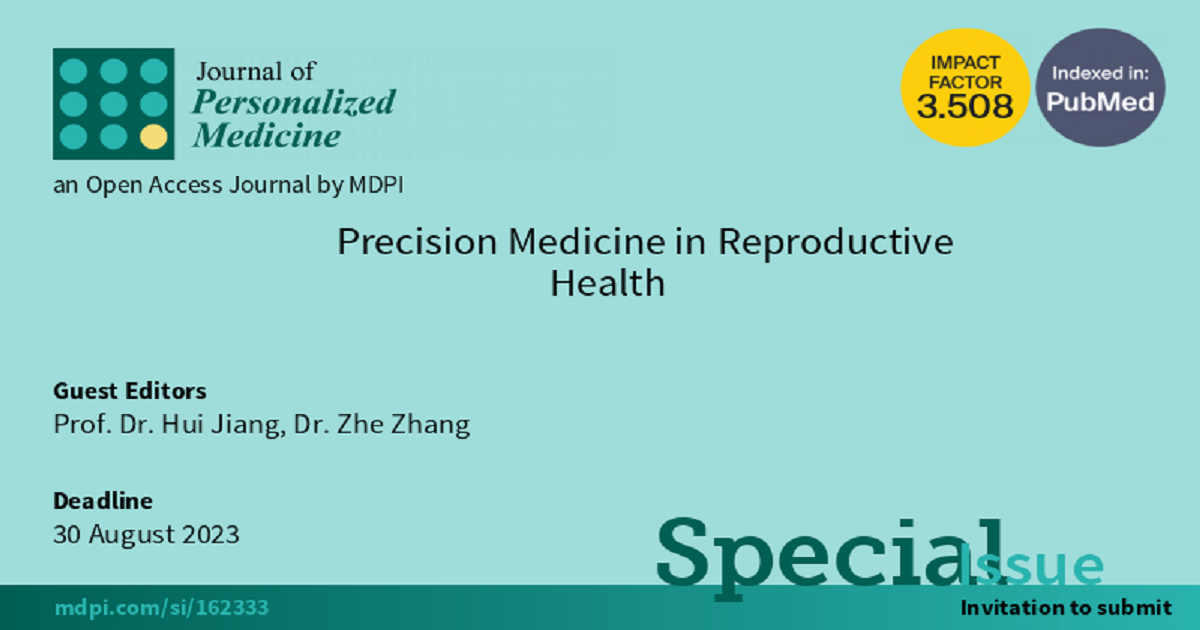Precision Medicine in Reproductive Health
A special issue of Journal of Personalized Medicine (ISSN 2075-4426). This special issue belongs to the section "Sex, Gender and Hormone Based Medicine".
Deadline for manuscript submissions: closed (30 August 2023) | Viewed by 13105

Special Issue Editors
2. Institute of Urology, Peking University, Beijing, China
3. Andrology Center, Peking University First Hospital, Beijing, China
Interests: andrology; reproductive medicine; male infertility; sexual dysfunction
2. Department of Andrology, Peking University Third Hospital, Beijing, China
3. Department of Reproductive Medicine Center, Peking University Third Hospital, Beijing, China
Interests: male infertility; azoospermia; genetic mutation; targeted drug delivery
Special Issue Information
Dear Colleagues,
With increased environmental pollution and delayed reproductive age, reproductive health, especially infertility, has become a major public health issue. Infertility affects about 10–15% of couples of reproductive age, and these individuals experience enormous physical and psychological stress as well as economic burden. In recent decades, with the development of in vitro fertilization, micro-testicular extraction sperm extraction, and targeted drug delivery, many couples suffering from infertility have been able to have their own children. However, there are still many infertility patients, especially with premature ovarian failure, azoospermia, etc., who cannot obtain biological offspring.
In recent years, precision molecular biology technologies such as gene therapy, targeted drugs, and in vitro differentiation systems have developed rapidly, which can remodel the meiotic process in vitro and produce healthy offspring in animal models. A variety of non-invasive detection and fertility assessment models also provide accurate screening methods and have been applied to individuals with infertility. This Special Issue of the Journal of Personalized Medicine aims to highlight some of the recent progresses focused on precision medicine in the diagnosis, prevention, and treatment of patients with infertility.
Prof. Dr. Hui Jiang
Dr. Zhe Zhang
Guest Editors
Manuscript Submission Information
Manuscripts should be submitted online at www.mdpi.com by registering and logging in to this website. Once you are registered, click here to go to the submission form. Manuscripts can be submitted until the deadline. All submissions that pass pre-check are peer-reviewed. Accepted papers will be published continuously in the journal (as soon as accepted) and will be listed together on the special issue website. Research articles, review articles as well as short communications are invited. For planned papers, a title and short abstract (about 100 words) can be sent to the Editorial Office for announcement on this website.
Submitted manuscripts should not have been published previously, nor be under consideration for publication elsewhere (except conference proceedings papers). All manuscripts are thoroughly refereed through a single-blind peer-review process. A guide for authors and other relevant information for submission of manuscripts is available on the Instructions for Authors page. Journal of Personalized Medicine is an international peer-reviewed open access monthly journal published by MDPI.
Please visit the Instructions for Authors page before submitting a manuscript. The Article Processing Charge (APC) for publication in this open access journal is 2600 CHF (Swiss Francs). Submitted papers should be well formatted and use good English. Authors may use MDPI's English editing service prior to publication or during author revisions.
Keywords
- reproductive medicine
- precision medicine
- infertility
- assisted reproduction
- targeted drug delivery
- gene therapy
- molecular diagnosis
Benefits of Publishing in a Special Issue
- Ease of navigation: Grouping papers by topic helps scholars navigate broad scope journals more efficiently.
- Greater discoverability: Special Issues support the reach and impact of scientific research. Articles in Special Issues are more discoverable and cited more frequently.
- Expansion of research network: Special Issues facilitate connections among authors, fostering scientific collaborations.
- External promotion: Articles in Special Issues are often promoted through the journal's social media, increasing their visibility.
- e-Book format: Special Issues with more than 10 articles can be published as dedicated e-books, ensuring wide and rapid dissemination.
Further information on MDPI's Special Issue policies can be found here.





